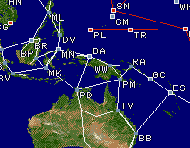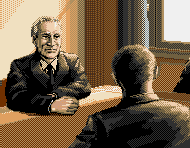

History: Koei is known for its games of court intrigue, supplies control, resource management, propitious marriages, and a myriad of other factors and statistics. While they are not role playing games, since there is no character development, the games are long drawn out affairs that balance game play with micromanagement skills that only an accountant like myself or someone interested in lots of choices and details would enjoy. PTO was originally released by KOEI several years ago, but the new game is an entirely different one, having been completely redesigned from the ground up.
Before Pearl Harbor, the battleship captains of the U. S. Navy were determined to keep the aircraft carrier at the rear of importance in sea battles. The Japanese in one way did the U. S. Navy a favor by leaving them with only their carriers to fight the Pacific War. The Japanese also demonstrated conclusively the power of their six carriers when they pummeled Pearl Harbor and surrounding military and industrial locations to dust.
Plot: You take the role of the Chief of Naval Operations in charge of the war from one of ten starting points until the war’s end by military victory and not nuclear holocaust.
Game play: PTO2 is a turn-based strategy war game, with each turn composed of three parts: move, plan and battle. When in campaign conferences, you are given cards to play to influence the other leaders of the country to follow your plan of action.
Scenarios, Missions, Battles, and Careers: Seven Scenarios and three campaigns, each scenario is the same as a mission (a single battle) in other games. The scenario (mission) is scripted with the forces starting the battle in set locations, without the random placement seen in other games. While I prefer scripted games since they can have a well developed story and repetition of battles that are identical are much more adaptable for learning the game, when there are so few scenarios (missions) to play the game gets boring quick due to lack of variety.
The campaign game can encompass the entire war with decisions about
objectives being decided in monthly conferences. The discussions
determine objectives and budget and are basically negotiations with
heads of the government. These discussions determine what planes and
ships are built, sailors and soldiers conscripted, spies to find out
about U.S. plans, and a dizzying array of other factors that only Koei
would include in a game.

Combat: Battles result in damage to specific areas of the ship, with repairs appropriately handled on dry dock or at sea. The friendly artificial intelligence (AI) is not very good, it must be monitored constantly to prevent supply from being cut or not taking advantage of working on one objective at a time with overwhelming odds. Surprisingly, the enemy AI is quite adept at giving the friendly AI a drumming.
Graphics: Graphics in Koei games are characteristically weak with a grainy style of two dimensional graphics of low resolution and without any animation.
Music score: Highly repetitious and boring.
Voice actors: Narration
Video: Vintage video films from World War II are included
Sound effects: These effects are almost as bad as the beeps we used to get with computer games at the beginning when all we had was a PC speaker.
Multi-player: No options for this means the game has limited applicability to today’s group gaming philosophy.
Help: Pull down-help menu
References:
Michael Bowen, Computer Games Strategy Plus, issue 70, pg. 80, 3/5, (60%).
Michael Bowen, www.cdmag.com/war_vault/pto_2_review/page1.html (same as above.)